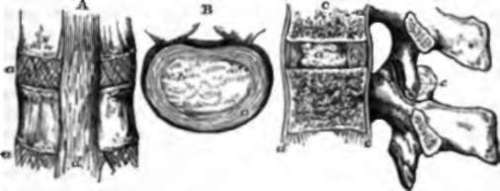Bone. Continued
Description
This section is from the book "Animal Physiology: The Structure And Functions Of The Human Body", by John Cleland. Also available from Amazon: Animal Physiology, the Structure and Functions of the Human Body.
Bone. Continued
24. While cartilage is capable of rapid growth, as has been already stated, by multiplication of its corpuscles and expansion of its matrix, bony tissue is capable of very little expansion, and increases in bulk by addition to its surfaces, where it is in contact with cartilage or fibrous tissue. Thus, a ring of silver fastened round the wing-bone of a young pigeon becomes gradually imbedded and covered in by the new depositions of bone on the surface, while, by the absorption which is at the same time going on internally, it may even come to lie in the enlarged cavity of the bone. John Hunter found, that if two holes were bored in a bone of a young animal, at a measured distance one from the other, afterwards when the bone had grown longer, the holes remained separated by the same interval as at first. Even apart, however, from the circumstance that subsequent observers on repeating Hunter's experiment have obtained a different result, it must be admitted that osseous tissue has some power, although limited, of interstitial expansion, seeing that the body of the lower jaw elongates by that means sufficiently to make room within it for the permanent teeth, and an expansion of the same sort takes place in the frontal bone between the frontal eminences and the margins of the orbits. But the principal elongation of the bones of the limbs is provided for by the extremities of the bones being furnished with separate epiphyses or supplementary centres of ossification, between which and the shaft there remains, as long as the growth of the bone continues, a thin plate of cartilage, which is as rapidly growing interstitially as it is converted into bone at its surface. So, also, the bones of the skull expand principally by additions at their edges, and when premature obliteration (synostosis) of any suture occurs, it causes arrest of growth at right angles to the suture, compensated for by additional growth in other directions, producing a variety of anomalous forms of skull 25. The Joints or Articulations, by which the different bones are joined together, may be divided primarily into movable and immovable.

Fig. 25. Tibia at 18 years of age, showing the superior and interior epiphyses.
All the bones of the skull, with the exception of the lower jaw, are united together by immovable articulations or sutures, many of them rendered firmer by the dovetailing of complicated serrations of the articulating edges. Such articulations are serviceable for purposes of growth, as has been already explained.
Movable articulations are divisible into complete or perfect, and incomplete or imperfect.
Incomplete joints are those in which the opposed surfaces of bone are united by intervening substance of a yielding description; and the most notable example of this mode of union is found in the vertebral column. The arches of the vertebrę are united by pairs of complete joints, but their bodies, the parts through which the weight of the trunk is principally conducted, are joined by intervertebral discs, consisting exteriorly of rings of oblique fibres, and more deeply of pulpy tissue, rich in corpuscles like cartilage-corpuscles. These discs are so many elastic pads which are useful in preventing shocks, and while little movement is allowed by them between each pair of bones, the amount permitted in the whole column is very considerable.

Fig. 26. Lumbar Intervertebral Disc. A, front view. B, horizontal section. C, section from before backwards, a, fibrous rings; b, pulpy tissue; c, articular surfaces in contact; d, anterior common ligament; e, posterior common ligament.
Complete joints are those in which the surfaces of bones coated with articular cartilage glide one against the other, while the ligaments which bind them together are placed round about. Internal to the ligaments there extends from the circumference of one articular surface to that of the other, a delicate synovial membrane, so called because from it there exudes sufficient fluid, termed synovia, to moisten the surfaces of the shut cavity which it encloses.
In the complete joints, the movements allowed vary greatly both in character and degree. In many, as, for example, between the individual bones constituting the second range of the carpus, and between some of the tarsal bones, the movement is extremely slight (arthrodia), and the principal advantage gained appears to be elastic resistance to pressure, by the weight being thrown upon tense ligaments. Others, in which the movements are extensive, may be rudely compared with joints made by mechanicians. Thus, the shoulder and the hip may be termed ball and socket joints, there being in each a rounded surface which moves in all directions against a cup; the elbow and the ankle furnish examples of hinge-joints, permitting angular movement in only one path, that of flexion and extension; and in the articulation of the first and second vertebrę, we have an instance of a pivot-joint, the odontoid process of the axis or second vertebra, being the pivot round which the atlas or first vertebra revolves.
Continue to:
